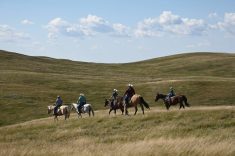Stroll through the trade show at a farm conference, and you’ll quickly find people who saw a need for a product for their own livestock and turned it into a business. The Jubinville family is one example.
“My dad invented the feeder and then my brother and I saw how well it worked and we decided to turn it into a business,” says Clayton Jubinville, who has displayed his feeder at several shows including Agribition in Regina last fall. Clayton’s father, Leonard, has a history of creating equipment such as a deer-handling system to improve his bison and whitetail operation,
Read Also

Harvest wraps up and fall work begins
At the Eppich famly ranch in western Saskatchewan, the fall harvest was successful with few breakdowns, cows and calves have been sorted and a new tractor has arrived
Today Clayton and his brother Delton own HayBoss Feeders, a company that sells livestock feeders designed to cut hay waste.
The feeder is suitable for horses, sheep and goats, along with exotics such as llamas, alpacas and deer. A platform and roof keeps the hay off the ground and out of the weather. Netting holds the bale in place and keeps animals from pulling out and trampling large chunks, Jubinville says. “It just saves the hay. Makes them eat small amounts, all day.”
HayBoss offers netting with two-inch or inch-and-a-half holes, along with one-inch inserts. Smaller holes make animals work harder for feed.
How much horse owners will save on feed depends on whether the horse is an easy keeper and how the product is used, Jubinville says.
For example, square bales in the two-inch netting wouldn’t slow down the horses but would eliminate waste, but netting with smaller holes would slow feeding further.
Jubinville says they created the product to cut feed waste, but discovered afterward that there are health benefits linked to continuous feeding in horses. The equine digestive system is designed for continuous eating, and so allowing horses to eat small amounts all day, rather than a couple of big servings, is optimal.
The Jubinvilles offer a 30-day, money-back guarantee and a one-year warrantee on the frame and all moving parts. Nets last between two to five years, says Jubinville, depending on the number of animals being fed and how aggressive they are. The feeder frame should last a lifetime, Jubinville says.
Other net feeders offer the same health benefits for horses, but HayBoss offers a few extra benefits. The feeder can be used on a fence line, allowing producers to feed two pens with a single feeder. The net also retracts automatically. All the metal is galvanized. Every round bale feeder comes with floor extensions and wood skids, for loading ease and general sturdiness.
“We consider it the Cadillac of net feeding,” says Jubinville.
For more information on HayBoss Feeders, visit haybossfeeders.com or call 1-844-HAY-BOSS (429-2677).
















